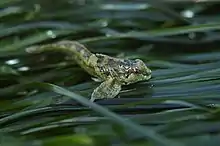Oligocottus
Oligocottus is a genus of marine ray-finned fishes belonging to the family Cottidae, the typical sculpins. These sculpins are found in the northern and eastern Pacific Ocean.
| Oligocottus | |
|---|---|
 | |
| Tidepool sculpin (O. maculosus) | |
| Scientific classification | |
| Domain: | Eukaryota |
| Kingdom: | Animalia |
| Phylum: | Chordata |
| Class: | Actinopterygii |
| Order: | Scorpaeniformes |
| Superfamily: | Cottoidea |
| Family: | Cottidae |
| Subfamily: | Cottinae |
| Genus: | Oligocottus Girard, 1856 |
| Type species | |
| Oligocottus maculosus Girard, 1856[1] | |
| Synonyms[1] | |
Taxonomy
Oligocottus was first proposed as a monospecific genus in 1856 by the French biologist Charles Frédéric Girard[1] when he described Oligocottus maculosus from Tomales Bay, San Francisco, California.[2] The 5th edition of Fishes of the World classifies this genus within the subfamily Cottinae of the family Cottidae,[3] however, other authors classify the genus within the subfamily Oligocottinae of the family Psychrolutidae.[1] The genus has been found to be a monophyletic grouping with the saddleback sculpin as the more basal of the four species with the other three species creating a polytomy.[4]
Etymology
Oligocottus prefixes oligos, meaning "small", with Cottus, the type species of the family Cottidae. This is an allusion to the small size of O. maculosus.[5]
Species
There are four species listed in this genus:[6]
- Oligocottus maculosus Girard, 1856 – Tidepool sculpin
- Oligocottus rimensis (Greeley, 1899) – Saddleback sculpin
- Oligocottus rubellio (Greeley, 1899) – Rosy sculpin
- Oligocottus snyderi Greeley, 1898 – Fluffy sculpin
Characteristics
Oligocottus sculpins are characterised within the sculpins by having the anus located immediately to the front of the origin of the anal fin, the intromittent organ of the males is shaped like a long, thin cone and the front rays of the males' anal fins are modified.[4] These sculpins are small fishes, with the largest being the rosy sculpin with a maximum published total length of 10 cm (3.9 in).[6]
Distribution and habitat
Oligocottus sculpins are found in the North Pacific, they are found off the along the Pacific coasts of North America from Alaska to Baja California. The tidepool sculpin has been reported from the Sea of Okhotsk and the Bering Sea but records west of the Gulf of Alaska are considered doubtful. They are found in the intertidal and subtidal zones and have the ability to breathe air.[6]
References
- Eschmeyer, William N.; Fricke, Ron & van der Laan, Richard (eds.). "Genera in the family Oligocottinae". Catalog of Fishes. California Academy of Sciences. Retrieved 11 February 2023.
- Eschmeyer, William N.; Fricke, Ron & van der Laan, Richard (eds.). "Species in the genus Genus-Oligocottus". Catalog of Fishes. California Academy of Sciences. Retrieved 12 February 2023.
- J. S. Nelson; T. C. Grande; M. V. H. Wilson (2016). Fishes of the World (5th ed.). Wiley. pp. 467–495. ISBN 978-1-118-34233-6.
- Matthew L. Knope (2013). "Phylogenetics of the marine sculpins (Teleostei: Cottidae) of the North American Pacific Coast". Molecular Phylogenetics and Evolution. 66: 341–349. doi:10.1016/j.ympev.2012.10.008. PMID 23099148.
- Christopher Scharpf & Kenneth J. Lazara, eds. (22 October 2022). "Order Perciformes: Suborder Cottoidea: Infraorder Cottales: Family Cottidae (Sculpins)". The ETYFish Project Fish Name Etymology Database. Christopher Scharpf and Kenneth J. Lazara. Retrieved 12 February 2023.
- Froese, Rainer and Pauly, Daniel, eds. (2022). Species of Oligocottus in FishBase. August 2022 version.